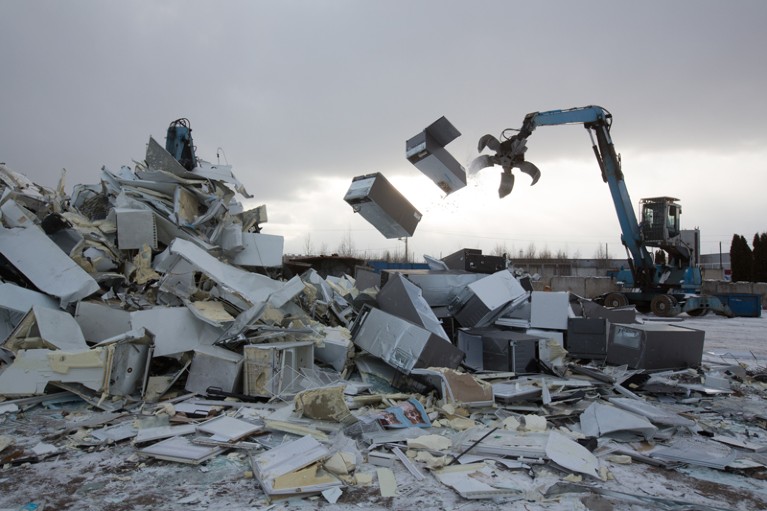
Current ‘linear’ economic models prioritize waste rather than reuse.Credit: Andrey Rudakov/Bloomberg/Getty
Producing a laptop computer that weighs a few kilograms takes around one tonne of raw metal, plastic and silicon. Between 2000 and 2015, global clothing production doubled, but the number of times the average garment was worn before being discarded decreased by 36%. The body of a modern car contains more than a dozen steel and aluminium alloys, putting up huge barriers to recycling it.
These are just three of many stark statistics that illustrate the wastefulness of our current ‘linear’ economic model, which is based on extracting virgin resources, processing them, consuming them and dumping them when they are no longer useful. This unsustainable approach is bad for the climate, for nature and for human health — and ultimately hits us in the wallet. One estimate by the global consultancy Accenture in 2015 suggested that US$4.5 trillion of extra value could be unlocked by creating products using ‘waste’ as a resource.
That is the grand vision of a ‘circular economy’, in which materials are recirculated and maintain the highest value possible, and as much waste as possible is eliminated. As detailed in a series of editorials this year and in a Nature Outlook on the circular economy published last month, innovations in materials and processes are making circularity a more realistic proposition in many sectors. Many businesses are making enthusiastic noises, too, scenting both new revenue streams and a public-relations win.
Yet practical implementations of circular principles so far amount to tinkering at the edges. Some serious thinking is needed about what must happen to make circularity a universal guiding principle. The answer is: a lot.
Some places are ahead of the game. China has been adopting circular-economy policies since the late 2000s. Its latest iteration of a circular-economy action plan, valid until 2025, sets ambitious targets for using scrap steel and construction waste, among other refuse. Its ban on importing plastic and other waste, implemented in 2018, has forced countries to rethink their own waste strategies.
The European Union announced a circular-economy action plan in 2020, and is looking towards implementing policies around substantiating sustainability claims by business, controlling packaging and incentivizing the use of recycled materials in manufacturing. Chile’s road map for a circular economy by 2040 involves targets for waste reduction and the creation of more than 100,000 jobs.
And there are smaller-scale, sector-specific initiatives. Since 2009, Japan has required manufacturers to collect and recycle the large home appliances that they make, although the costs are mostly borne by consumers. In Kawasaki, reusing industrial and municipal waste to make cement has caused greenhouse-gas emissions to fall by about 15% since 2009, saving 272,000 tonnes of material each year.
Such success stories must be learnt from, and governments across the world must implement legislation and regulations to incentivize investment in circularity. But there’s more to it than that. Circularity requires a complete rethink of our perception of resources — and how we build our economic activities around them.
Circularity can only work if the link between a company producing more stuff and making more money is broken. Businesses need to be designed from the start (or redesigned) to be circular. The inherent value in resources needs to be recognized — for example, by dismantling and repurposing mobile phones or laptops for markets in which the latest models are not required. Price structures need to change to incentivize the production of items that can be usefully reused — so that resources retain their value through more than one cycle of use.
Governments and international authorities must underpin this with serious conversations about how to mandate standardization without stifling innovation. For example, electric-vehicle batteries aren’t interchangeable, creating a huge problem for their disassembly and reuse. The Battery Passport initiative, instigated by the World Economic Forum, aims to address this by establishing a circular model for battery use by 2030.
The circular economy can itself be a wellspring of innovation. There are big opportunities for innovators to create businesses that offer solutions, whether software that helps others to make the shift to circularity, or companies that offer services for rental and return, rather than purchase and disposal: car-sharing, rather than car ownership, for instance. That transition isn’t going to be easy. There will be hurdles to overcome, including refurbishment costs and setting fair leasing prices.
Last but not least, basic science has a part to play. As the father of the circular-economy idea, Walter Stahel, wrote in Nature in 2016, “Excellence in metallurgical and chemical sciences is a precondition for a circular economy to succeed” (W. R. Stahel Nature 531, 435–438; 2016). Ultimate recyclability lies in learning how to disassemble materials at the atomic level, splitting up molecules to recycle atoms. Funding agencies should be scanning the horizon for promising approaches, in areas from metal alloys to plastics.
There’s a lot to do to get the wheels of the circular economy truly turning. The movement has started — but it must accelerate.

 The circular economy
The circular economy
 How to globalize the circular economy
How to globalize the circular economy
 Concrete needs to lose its colossal carbon footprint
Concrete needs to lose its colossal carbon footprint
 Lithium-ion batteries need to be greener and more ethical
Lithium-ion batteries need to be greener and more ethical
 Protect global supply chains for low-carbon technologies
Protect global supply chains for low-carbon technologies








